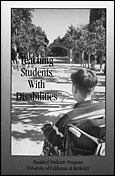Campus Develops Guide to Teach Students With Disabilities
New Manual Offers Suggestions to Faculty On How to Approach Course Work
By Tamara Keith and D. Lyn Hunter, Public Affairs
Posted September 22, 1999
 |
He has cerebal palsey and cannot control the movement of his arms. They are strapped down to the railings of his battery-operated wheelchair.
But that doesn't stop the 20-year-old junior from getting his professors' attention. "I just jump in. I'm very good at that," Berk said.
At the beginning of each semester Berk makes sure his professors know about his disability to preempt any potential misunderstanding.
"I don't give them the chance," he said. "What I've always done is meet with my professor as soon as possible and, not only tell them what I need, but also get to know them and establish a relationship. That's really how you make things work for you."
Disabled students like Berk will now have help explaining their needs to professors. The campus's Disabled Students' Program has created a manual on teaching students with disabilities that will be distributed to all Berkeley faculty.
The manual's author, Caroline Summer, said she hopes it will help make campus classrooms more disability friendly.
"There are many things the faculty may not be aware of regarding the needs of disabled students," she said. "By increasing their disability awareness, faculty can improve the educational experience for both disabled students and themselves."
Teaching the disabled involves much more than just making sure a classroom is wheelchair accessible. The campus's nearly 900 disabled students have diverse needs. Their disabilities include mobility, visual or hearing impairments, chronic illnesses, psychological disorders and learning disabilities.
The manual, "Teaching Students with Disabilities," describes the various disabilities that teachers may encounter and offers suggestions on how to approach the course work for these students.
For example:
- For students who, like Burk, want to participate in class discussions but are not be able to raise their hand, teachers should establish eye contact and call on students who indicate they wish to contribute.
- The use of Internet Web sites in course work is becoming increasingly popular. When building these sites, instructors are encouraged to limit the use of image icons as navigating tools. Many students with visual disabilities use assistive technology software that reads text on a computer screen aloud, but cannot process image icons.
- Those suffering from chronic pain may be unable to use the kind of chairs provided in most classrooms, forcing them to stand during class. Podiums may need to be provided on which students can rest open books and write.
- When showing videos or slides in the classroom, teachers should use captioning so the deaf and hard of hearing can process the information presented. If the classroom must be darkened, make sure that the student's interpreter is clearly visible.
- When teaching students with attention deficit/hyperactivity disorder, instructors are encouraged to start each lecture with a summary or outline of material to be covered, provide test-sites that are relatively distraction-free, and avoid making oral assignments.
According to Summer, the publication was created at the request of both instructors and students.
"Faculty requested it because they want to know how to better teach disabled students," said Summer. "The students wanted it because they want their professors to understand their disabilities but feel more comfortable with the information coming from an objective source."
Berk was one of those students.
"I think it will be a big help," he said. "The bottom line is, it promotes awareness, and that's the most important thing."
Berk said the manual will make it easier for disabled students to approach their professors.
"With or without this book, you need to go talk to your professors because everyone has different individual needs," he said. "But, the fact that professors will know that people have those needs is a big help."
The Academic Senate will be mailing copies of the manual within the next few weeks. For information, call Caroline Summer at 642-0518.
![]()
![]()
September 22 - 28, 1999 (Volume 28, Number 7)
Copyright 1999, The Regents of the University of California.
Produced and maintained by the Office of Public Affairs at UC Berkeley.
Comments? E-mail berkeleyan@pa.urel.berkeley.edu.